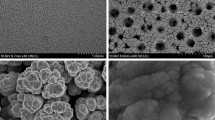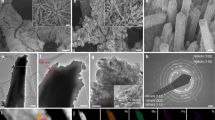Abstract
Ternary manganese–molybdenum–tungsten oxides were anodically deposited on to IrO2-coated titanium substrates at current densities of 60–600 A m−2 in 0.4 M MnSO4 solutions containing 0.003 M Na2MoO4 and 0.003 M Na2WO4 at pH 0–1.5 and at 30–90 °C. The effect of anodic deposition conditions on the activity, selectivity and durability of the anodes for oxygen evolution in 0.5 M NaCl solution was investigated. Most of the oxide anodes prepared initially gave an oxygen evolution efficiency of almost 100%. When the anodic deposition was performed at temperatures lower than 90 °C, gradual oxidative dissolution occurred during the electrolysis in the NaCl solution, due to formation of poorly crystalline oxides. In contrast, the oxide deposited at 90 °C revealed no obvious dissolution during electrolysis for more than 1500 h. The oxygen evolution efficiency, however, decreased gradually with time of electrolysis because of partial detachment of the deposited oxide. The anodic deposition in electrolytes at lower pH and at higher current density resulted in the formation of oxides with better adhesion to the substrate, resulting in improved anode durability. The durability was further improved by repeated anodic deposition with the oxide surface washed during intervals.
Similar content being viewed by others
References
J.E. Bennett, in T.N. Veziroglu and W. Seifritz (Eds) Proceedings of the 2nd World Hydrogen Energy conference, (Pergamon Press, Oxford, 1978), p. 291.
J.E. Bennett, Int. J. Hydrogen Energy 5 (1980) 401.
M. Hiroi, M. Muroya, E. Tada and S. Ogawa, Denki Kagaku 57 (1989) 837.
M. Hiroi, Y. Takemoto, M. Muroya, E. Tada and S. Ogawa, Denki Kagaku 58 (1990) 184.
K. Izumiya, E. Akiyama, H. Habazaki, N. Kumagai, A. Kawashima and K. Hashimoto, Electrochim. Acta 43 (1998) 3303.
K. Fujimura, K. Izumiya, A. Kawashima, H. Habazaki, E. Akiyama, N. Kumagai and K. Hashimoto, J. Appl. Electrochem. 29(1999) 769.
K. Fujimura, T. Matsui, K. Izumiya, N. Kumagai, E. Akiyama, H. Habazaki, A. Kawashima, K. Asami and K. Hashimoto, Mater. Sci. Eng. A267 (1999) 254.
K. Fujimura, T. Matsui, H. Habazaki, A. Kawashima, N. Kumagai and K. Hashimoto, Electrochim. Acta 45 (2000) 2297.
H. Habazaki, T. Matsui, A. Kawashima, K. Asami, N. Kumagai and K. Hashimoto, Script. Mater. 44 (2001) 1659.
Author information
Authors and Affiliations
Corresponding author
Rights and permissions
About this article
Cite this article
Matsui, T., Habazaki, H., Kawashima, A. et al. Anodically deposited manganese–molybdenum–tungsten oxide anodes for oxygen evolution in seawater electrolysis. Journal of Applied Electrochemistry 32, 993–1000 (2002). https://doi.org/10.1023/A:1020912611494
Issue Date:
DOI: https://doi.org/10.1023/A:1020912611494




